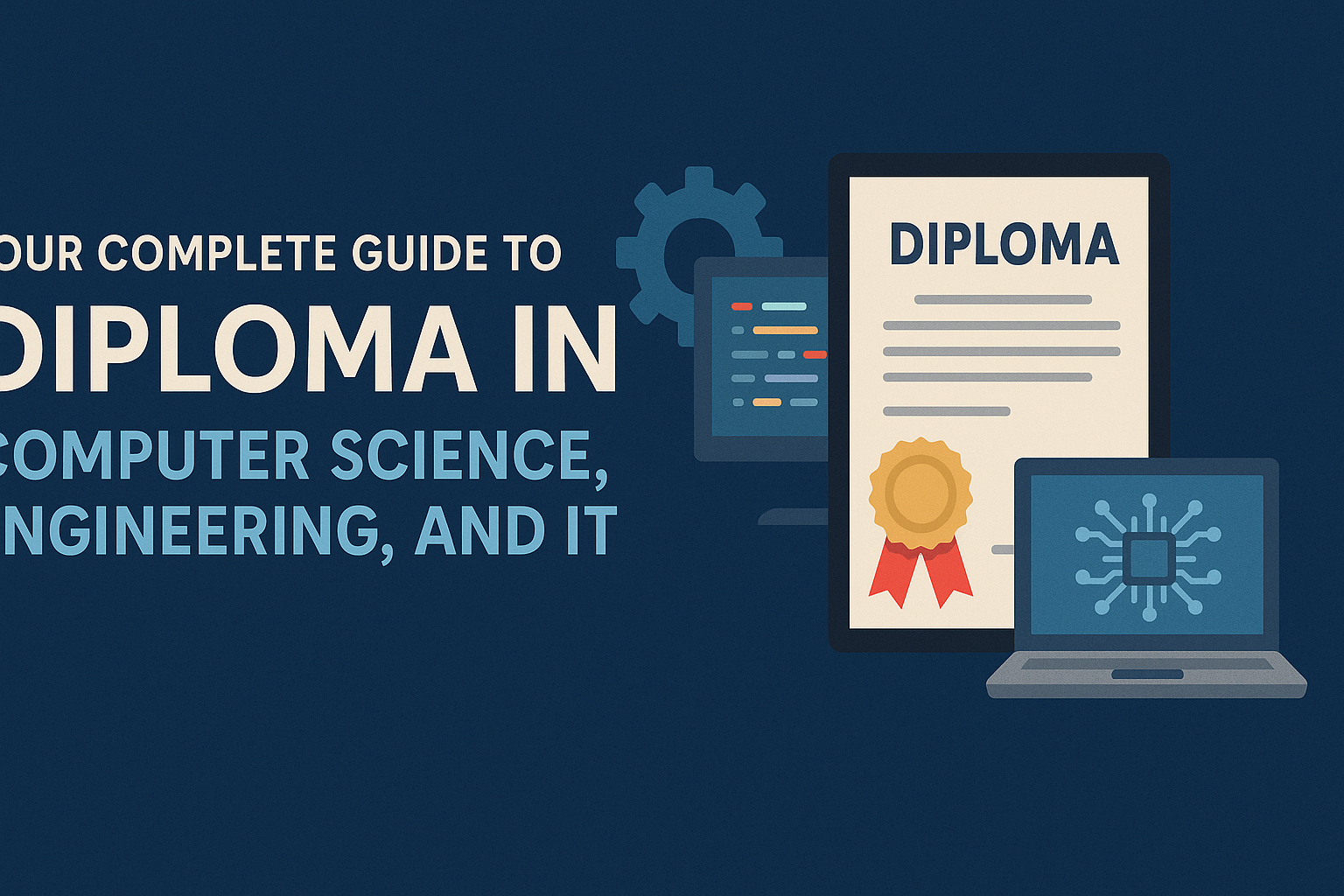Thinking about a career in tech? A diploma in Computer Science, Computer Engineering, or Information Technology could be your perfect entry point. It’s a practical, hands-on qualification that can get you into the workforce quickly or serve as a powerful launchpad for a full engineering degree.
This guide breaks down everything you need to know—from picking the right program to landing your first job.
First Things First: What Are Your Options?
You’ll see a few different program titles, but they all revolve around the same core skills. The most common are Diplomas in Computer Science (or CSE), Computer Engineering (CE), and Information Technology (IT). While they share a lot of DNA, there are subtle differences. Computer Engineering often leans more into hardware—think microprocessors and circuit design. Information Technology tends to focus on the application side, like web development and network administration. Computer Science usually offers a balanced mix of both.
The standard program is three years, split into six semesters. But there’s a popular fast-track option called Lateral Entry. If you’ve already completed your 10+2 in the Science stream or a relevant two-year ITI course, you can skip the first year and finish your diploma in just two years.
Is This Diploma Legit? The Importance of Approval
This is crucial. For your diploma to be worth anything, it needs a two-level seal of approval. At the national level, the program must be approved by the All India Council for Technical Education (AICTE). Think of this as the non-negotiable quality check that ensures the college meets national standards.
At the state level, the college will be affiliated with a State Board of Technical Education, like MSBTE in Maharashtra or HSBTE in Haryana. The State Board sets the syllabus, conducts exams, and awards your diploma. This dual system means your qualification is credible and recognized anywhere in India.
Getting In: The Admission Process
For first-year entry, the requirement is straightforward: you need to have passed your Class 10 (SSC) exams with at least 35% to 50% marks, making sure you’ve passed in Mathematics and Science.
The selection process varies by state. Most use a merit-based centralized counseling system, where your Class 10 marks determine your rank. Others, like Delhi, hold a Common Entrance Test (CET). The online application itself is your first taste of the digital world you’re about to enter—a practical lesson in navigating the kind of rule-based systems you’ll one day build.
When it’s time to apply, you’ll need a folder with your academic mark sheets, transfer and character certificates, any reservation or quota documents (like caste or domicile certificates), photos, and a government ID. Keep both originals and photocopies handy.
What You’ll Actually Learn: A Look Inside the Curriculum
A diploma isn’t just about theory; it’s about building skills you can use on day one of a job. The curriculum is designed to take you from foundational concepts to specialized, in-demand technologies.
You’ll start with the basics like Applied Mathematics, Physics, and fundamentals of programming in a language like C. As you move through the semesters, you’ll dive into core subjects:
- Data Structures and Algorithms
- Object-Oriented Programming (using C++ or Java)
- Database Management Systems (with a heavy dose of SQL)
- Operating Systems and Computer Networks
- Web and Mobile App Development
The final year often introduces you to emerging fields like Cloud Computing, Cybersecurity, and the basics of AI and Machine Learning. But the real magic happens in the labs. Every theoretical subject is paired with intensive practical sessions where you’ll write code, configure networks, and build applications.
The program culminates in a mandatory 4-6 week industrial internship and a final-year capstone project. The internship gives you a feel for the corporate world, while the project is your chance to build a complete software or hardware solution from scratch.
Beyond the Classroom: The College Experience
What separates a good polytechnic from a great one? It’s the environment and the opportunities outside of lectures.
A modern tech education relies on solid infrastructure. Look for colleges with well-equipped programming labs, a dedicated networks lab (with real routers and switches or professional simulators), and a hardware/IoT corner with kits like Arduino or Raspberry Pi. The software you learn on should be what companies actually use: think VS Code, Git/GitHub, Docker, Postman, and modern frameworks like React or Node.js.
But it’s the connection to the industry that truly makes a difference. The best colleges organize industrial visits, establish partnerships with local IT firms for internships and guest lectures, and run workshops on practical skills like cloud fundamentals or ethical hacking. These experiences are what make your resume stand out.
Your Future in Tech: Career Paths and Next Steps
A diploma in computing gives you a powerful choice: start your career immediately or use it as a stepping stone to higher education. This flexibility is its greatest advantage—it provides an employable credential midway through your educational journey, de-risking your future.
Option 1: Enter the Workforce Graduates are ready for a variety of entry-level roles where practical skills are valued. You could become a:
- Junior Software or Web Developer
- QA/Test Engineer
- IT Support or Helpdesk Technician
- Network Technician
- Database Assistant
These jobs aren’t just in big IT companies. Opportunities are everywhere, from e-commerce and FinTech startups to the IT departments of manufacturing firms and government projects. Reputable colleges report placement rates from 60% to over 90%, with average starting salaries in the range of ₹2.5 LPA to ₹3.5 LPA.
Option 2: Pursue a B.Tech. Degree This is where the Lateral Entry pathway becomes a game-changer. Your diploma makes you eligible to join the second year of a B.E. or B.Tech. program directly, saving you a full academic year. You’ll enter the degree program with a strong practical foundation that often gives you an edge over students coming straight from 12th grade.
The Practical Stuff: Fees, Scholarships, and Support
The cost of a diploma varies wildly. Government polytechnics are heavily subsidized and can cost as little as ₹3,000 to ₹25,000 per year. Private institutions are self-financed, so their fees are higher, typically ranging from ₹35,000 to over ₹1,00,000 annually.
Don’t let the cost deter you. Numerous scholarships are available. The AICTE offers several key schemes:
- PRAGATI Scholarship: For meritorious female students.
- SAKSHAM Scholarship: For specially-abled students.
- SWANATH Scholarship: For orphans or children who lost parents to COVID-19.
These scholarships often provide around ₹50,000 per year to help with expenses. Additionally, there are state-level Post-Matric scholarships for reserved categories and a Tuition Fee Waiver (TFW) scheme for economically weaker students.
Making Your Final Choice
When you’re comparing colleges, look beyond the brochure. Check for two key quality signals: AICTE approval (which is mandatory) and NBA accreditation. NBA accreditation is a voluntary but rigorous process that signifies a high standard of academic quality and makes your diploma more valuable to employers.
Also, consider the student support systems. Do they have faculty mentoring, active student clubs (like a coding club or a Google Developer Student Club), and a placement cell that offers resume workshops and mock interviews? These elements contribute to a well-rounded education and prepare you for a successful career.
A diploma in computing is more than just a certificate—it’s a direct and practical path into the heart of the tech industry. Choose wisely, work hard, and it can open doors you never thought possible.




Pingback: Cyber Jobs Boom: No Degree Needed for a $124K Career
Pingback: ISRO Re-opens 45-day Internships 2025: Diploma, Engineering Tech Students Can Apply Now.